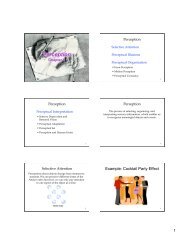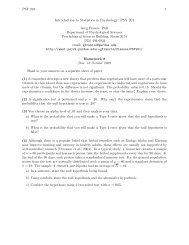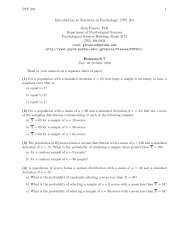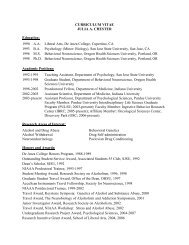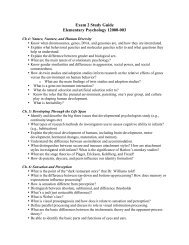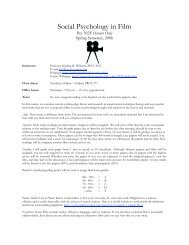Introduction to Cognitive Psychology - Department of Psychological ...
Introduction to Cognitive Psychology - Department of Psychological ...
Introduction to Cognitive Psychology - Department of Psychological ...
You also want an ePaper? Increase the reach of your titles
YUMPU automatically turns print PDFs into web optimized ePapers that Google loves.
Pr<strong>of</strong>. Greg Francis 1/2/13CosmeticsIt makes sense for people <strong>to</strong> interpret faces this way, because it reflects truedifferences between male and female facesMore so than men, the eyes and mouth <strong>of</strong> women tend <strong>to</strong> be darker than their skinCosmeticsContrast alone is enough <strong>to</strong> modify femininity (most neurons in the visual systemare sensitive <strong>to</strong> contrast)The two images have the same skin luminance, but the one on the right has darkermouth and eye regionsWomen wearing cosmetics have greater contrast than women not wearingcosmetics (Russell, 2009)Purdue UniversityPurdue UniversityFacial agnosiaSome people (maybe 3% <strong>of</strong> the population) cannot recognize faces or reademotions from facesFamous faces test:Prosopagnosiahttp://www.faceblind.org/facetests/index.phpMany people have it all their lives but do not realize it Recognize people by characteristics other than facesCannot recognize themselves in a pho<strong>to</strong>graph by face aloneThey know there are different faces, but they all look the sameWith fMRI, we can identify placesin the brain that responddifferently <strong>to</strong> faces compared <strong>to</strong>other stimuliThis image looks like a youngman with a cap in pr<strong>of</strong>ile There is a set <strong>of</strong> images like this(called Mooney images)FMRI <strong>of</strong> facesPurdue UniversityPurdue UniversityInverting the image changesthe percept dramaticallyWhat happens in the brain?fMRI scan while viewing eachtypeSubtract responses <strong>to</strong> find thedifference map There should be activity thatis present when seeing a facebut not present when notseeing a face Activity at other visual areasshould be similarFMRI controlfMRIStronger responses <strong>to</strong> facesFusiform Face Area (FFA) Region in the fusiform gyrus Region <strong>of</strong> the temporal lobe Especially in right hemispherePurdue UniversityPurdue UniversityPSY 200: Intro. <strong>to</strong> <strong>Cognitive</strong> <strong>Psychology</strong> 3



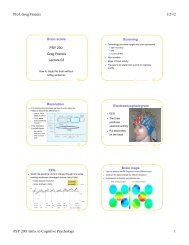


![Exam 4 Study Guide[1]](https://img.yumpu.com/45196739/1/190x245/exam-4-study-guide1.jpg?quality=85)
